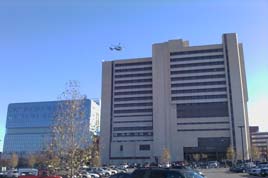Specialty
Noise / Vibration
SECTOR
Public Health
TYPE
Permitting / Compliance
CLIENTELE
Quasi-Public/Institutions
TIMESPAN
2010 - 2011LOCATION
Buffalo, NY
Project Number:
3426Buffalo General Hospital: Helipad Noise Analysis
SERVICE:
Acoustic Modeling Study
DESCRIPTION:
Kaleida Health was proposing a rooftop helipad to permit the emergency transport of patients to Buffalo General Hospital. Before proceeding with the project, they needed to confirm that the noise generated by this helicopter would not exceed Federal Aviation Administration (FAA) regulations for the residential areas surrounding the hospital. (These regulations state that cumulative exposure of aircraft noise must be less than 65 dB DNL). This study was necessary for the local permit application to the Buffalo Common Council. Tech was retained by Harter Secrest & Emery LLP (the law firm retained by Buffalo General Hospital) to conduct an acoustic modeling study. This study would determine whether or not the proposed helipad would be in compliance with federal noise regulations.
Tech conducted a thorough acoustic modeling of helicopter noise impacts in residential areas along the flight paths using the FAA's INM acoustic model. Tech established existing ambient sound conditions based on land use conditions and selected four noise-sensitive areas in which to conduct the helicopter acoustic modeling analysis. The results of the modeling revealed that the noise generated by the helicopter flight path was well below the FAA limit. Tech presented the results of the study at a neighborhood meeting and a Common Council meeting. As a result of these efforts, Kaleida Health was able to proceed with their rooftop helipad project.
Key Points
- Kaleida Health needed to confirm that its proposed Buffalo General Hospital rooftop helipad would be in compliance with FAA noise regulations for residential areas in the surrounding community.
- Tech conducted an acoustic modeling study which confirmed that the additional noise from the proposed helicopter flight path was compatible with the existing land use in the surrounding communities.

